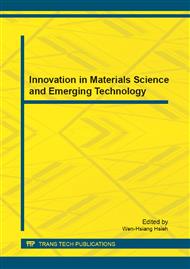p.499
p.505
p.510
p.515
p.520
p.525
p.530
p.536
p.542
Etching Method of the Fabrication Optical Tapered Fiber and its Formula
Abstract:
Optical tapered fiber is one of the most high efficiency evanescent wave coupler for coupling light into and out the optical microcavity. We fabricated the tapered fiber with etching method in a designed groove with HF solution. This method was low cost, readily, and controllable. An etching groove had an oval in the middle and small V-shape towards both sides. HF solution was injected into the oval groove, while the deioned water was injected into the two V-grooves. Because of the solution diffusion, the etching rate was fast in the mid and decreased gradually towards both sides,the tapered fiber was fabricated. The optical power meter was monitoring the fiber transmission during the etching process. The transmission of the tapered fiber was 98%. We proposed a mathematics model to depict the etching process, containing the relationship between the diameter of tapered fiber and the concentration of the HF solution, the etching time, humidity, temperature. We supervised the optical intensity to deduce the tapered fiber diameter. Surface morphology with AFM was detected, the roughness of the tapered fiber surface is less than 1nm. As an evanescent coupler, we used the tapered fiber to transmit 980nm pump laser to couple to Er3+ doped microsphere to stimulate 1557nm laser.
Info:
Periodical:
Pages:
520-524
Citation:
Online since:
December 2011
Authors:
Price:
Сopyright:
© 2012 Trans Tech Publications Ltd. All Rights Reserved
Share:
Citation:


